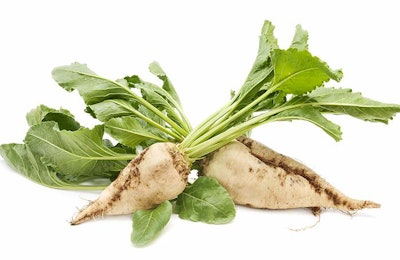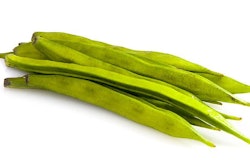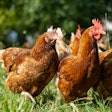
The major metabolic function of betaine is well-known, but it suffices to reiterate that betaine is a direct donor of methyl groups, a function similar to that of vitamin choline and amino acid methionine. In this respect, betaine can replace (or spare) methionine and choline. In addition, betaine is an osmotic regulator, one of the most important in physiology, acting in a way that keeps cells well-hydrated — a function that comes in handy during heat stress. Limited work has highlighted betaine as a lipotropic; it turns fat towards lean tissue synthesis, assuming there is sufficient protein in the feed.
Read more about betaine: Betaine can spare dietary methionine, choline
Today, when poultry diets are fortified with betaine, a synthetic form and most often of China industrial origin, is used. There are a number of betaine chemical forms available, with anhydrous, monohydrate and hydrochloride betaine being the most widely available. Likewise, price and quality varies, as one would expect from any additive that has become an industrial commodity.
Depending on the price of chemical betaine and those of choline and methionine (both similar commodities), the use of betaine increases or decreases, assuming the correct factors are assigned to betaine as a methyl donor. Seasonal fluctuations in use are also observed, with summer months demanding heavier use as betaine is included in summer heat-stress nutritional supplements.
What is natural betaine?
Apart from chemically-derived betaine, a natural form is also available, albeit in limited quantities. It comes from sugar beets in the form of a liquid concentrate of molasses. Molasses is a useful co-product of sucrose extraction from sugar beets, which contain so much betaine that this molecule was first discovered in beets, hence its name — betaine! Most of the betaine in beets is in the molasses fraction, and its concentration creates a betaine-rich liquid product that can be used as an additive.
There is no universal additive, just like there is no magic additive.
Natural betaine contains about 400 ppm betaine, compared to about 800 ppm in synthetic betaine products. As such, inclusion rates can be easily assumed to be roughly twice for the natural versus the synthetic product. Most poultry diets contain from 200 to 1,000 ppm pure betaine (regardless of source).
When is natural betaine preferred?
Despite any price differences, which always depend on volume, distance, etc., the use of a natural source of betaine can be deemed preferable in the following cases — not all of which might apply together.
- In organic poultry nutrition, synthetic methionine is not allowed (at least in some schemes throughout the world). The same is true for all similar additives, making the use of synthetic choline and chemical betaine impossible. Methionine is the first limiting amino acid in poultry diets, and without methionine supplementation, modern hybrids cannot reach their genetic potential. Thus, organic farming has been characterized by slow growth rates (broilers) and reduced layer performance (low egg numbers and low egg weight). Using a natural source of methyl, donors can bypass the issue of methionine/choline deficiency, allowing for greater performance.
- Some nutritionists, including myself, often opt for a wholesome ingredient that contains a major additive/compound instead of its purified form. This is the case, for example, when it comes to functional fibers, where I expect to find a greater use from a complex source of fibers versus a purified one. Perhaps the same holds true to natural betaine that includes many more biomolecules than just betaine due to its concentrated and not purified form. Perhaps this is not correct, but this thinking is not uncommon among nutritionists.
- Feed mills with advanced liquid application capabilities opt for liquid additives to depreciate the cost of the machinery. In such cases, any possible liquid additive offers logistics-related savings to them. Here it merits to note that such liquid application systems are very accurate, albeit expensive, thus minimizing errors and waste.
- Certain feed mills that place a premium on quality over cost often prefer to buy “locally” from a known supplier rather than a faceless “supermarket.” This has nothing to do with the source of materials, per se, but rather with the lack of adequate in-house quality control mechanisms. A single, local, direct source can be more reliable compared to an unknown trader sourcing from a number of manufacturers. Again, it is a matter of logistics and quality control.
- The term natural carries a specific weight in certain markets and products; a prestige different from that enjoyed by formal certification systems. As such, when one tries to design a “natural” diet, any ingredient used with such origin can enhance the image of the final product. Of course, this is not an easy exercise, but it does come into play on certain occasions.
When is natural betaine not suitable?
Like any additive that I have worked with, there is a well-balanced list of pluses and negatives. There is no universal additive, just like there is no magic additive. Thus, natural betaine cannot or should not be used in the following cases.
- If cost per kg or lb of feed is the most important criterion, then any ingredient that carries a price premium is automatically rejected, and it takes little imagination to understand that natural ingredients can carry a price premium when bought in small quantities.
- Not all feed mills want to invest in a liquid application system, although less-expensive systems do exist today. In this case, using any liquid additive is simply not possible. But, more and more additives are being converted into liquid forms that can be added in feeds with greater precision. So, it merits keeping this in mind.
- Where dry betaine is not used already, it would be difficult to introduce a liquid source of betaine. Betaine remains one of those additives that require considerable marketing/training to become a mainstream additive.
Natural liquid betaine is another interesting additive that has unique advantages over synthetic, dry betaine sources. At the same time, it can be more expensive to use as quantities remain limited, hence demand dictates a better price in smaller volumes. The balance, of course, lies with each nutritionist’s final decisions and marketing goals. Natural or synthetic, betaine remains an undervalued and rather poorly understood methyl donor that should be considered alongside choline and methionine.


















